|
|
|
INPUT/OUTPUT MODULES, LONWORKS |
|
|
4 Analogue Inputs/ 2 Analogue Outputs LonWorks
Node
The LAIO is a 4 channel analog input, 2 channel
analog output LonWorks node.
The LAIO allows the user to read the 4 analog
input signals, and control the 2 analog outputs.
It is useful for connecting an AP interface, or
any other analog device to the LonWorks network.
LAIO input 0-20 mA and 10,000 ohm thermistor.
Two jumper selectable outputs, 0-10Vdc and 0-20mA
are available.
LAIO uses the LonTalk network protocol and an
FTT-10A free topology bus transceiver.
The LAIO incorporates a service LED and service
push button switch for network configuration and troubleshooting.
|
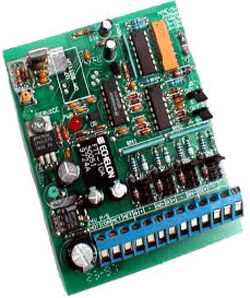
LAIO
|
|
|
One Analog Input and Output LonWorks Node
The LIO is a single channel analog input, single channel analog
output LonWorks node.
The analog input on the LIO allows a motor
position feedback signal to be monitored by the LonWorks network.
The LIO input is jumper selectable for
0-5, 0-10Vdc, 0-20mA or 10,000 ohm
thermistor.
In addition, it accepts a resistance input from
control motor auxiliary potentiometers and Version 1 offers a choice of
direct or reverse acting input via network variables (each sepa-rately).
A jumper selectable output of 0-10 Vdc or
0-20mA is available and Version 1 the LonTalk network protocol and an
FTT-10A free topology bus transceiver and incorporates brownout
protection.
The LIO is equipped with a service LED and
service push button switch for network configuration and troubleshooting.
|
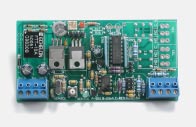
LIO |
|
|
|
|
One Analog Input and Output with Rotary Switch
and Push Buttons
The LIO-4DI is a single channel analog input, single channel analog
output LonWorks node.
The rotary switch and push buttons are read upon
change of state, with their new status being broadcast over the network
as determined by configuration variables set by the user.
The analog input on the LIO-4DI allows a motor
position feedback signal to be monitored by the LonWorks network.
The LIO-4DI input is 10,000 ohm thermistor.
In addition, it accepts a resistance input from
control motor auxiliary potentiometers.
A jumper selectable output of 0-10Vdc or
0-20mA is available.
The LIO-4DI uses the LonTalk network protocol and
an FTT-10A free topology bus transceiver and incorporates brownout
protection.
The LIO-4DI is equipped with a service LED and
service push button switch for network configuration and troubleshooting. |
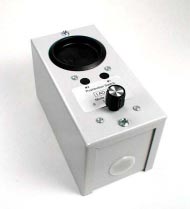
LIO-4DI |
|
|
One Analog Input and Two Relay Output LonWorks
Node
The LTR is a LonWorks node with one analog
input (eight bits of resolution) and two relay outputs. Its two form C
relay outputs are for staging (Version 1) or floating point
(Version 2) control of FTT-10A free topology bus transceiver.
The LTR incorporates a service LED and service
push button switch for network configuration and troubleshooting.
|
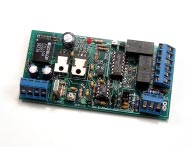
LTR
|
|
|
One Analog Input and Two Relay Output with
Rotary Switch and Push Buttons
The LTR-4DI is a LonWorks node with one analog input, rotary switch
and pushbuttons for user defined control (i.e. Off, Low, Med, High,
etc.), and two relay outputs.
The analog input has eight bits of resolution.
The rotary switch and push buttons are read upon
change of state, with their new status being broadcast over the network
as determined by configuration variables set by the user. Its two form C
relay outputs control closed loop actuators, with the feedback outputs
are updated.
The LTR-4DI input is jumper selectable for 0-5,
0-10Vdc, 0-20mA or 10,000 ohm thermistor range.
In addition, it accepts a resistance input from
control motor auxiliary potentiometers.
The two form C relay outputs are capable of 2A at
30Vdc or 0.6A at 125Vac.
The LTR-4DI uses the LonTalk network protocol and
an FTT-10A free topology bus transceiver.
The LTR-4DI incorporates a service LED and
service push button switch for network configuration and troubleshooting. |
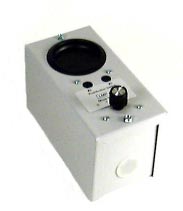
LTR-4DI |
|
|
LonWorks Pneumatic Node
The PNO*.1 is a LonWorks compatible pneumatic output node.
It uses the LonTalk network protocol and an
FTT-10A free topology bus trans-ceiver.
The PNO*.1 uses standard kPa (kilopascals) SNVT
(Standard Network Variable Types) to measure and control the BRANCH line
output pressure from 0 to 117.2kPa (17PSI) in 0.69kPa (0.1PSI)
increments.
If the BRANCH set-point pressure cannot be
achieved within two minutes a network alarm message is sent.
The PNO*.1 incorporates a SERVICE LED and SERVICE
push button switch for network configuration and troubleshooting.
The PNO0.1 is a single valve version with no
restrictor and does not bleed or exhaust air. Its operation depends on
the pneumatic circuit where it is installed to consume between 14 and 73
determined by the orifice size and pressure differentials.
If power fails, the PNO1.1, 5.1, or 7.1 will
continue to bleed through the orifice until branch pressure is zero psig.
A 3-way solenoid valve assembly may be used with
the PNO1, 5, or 7 to prevent it from exhausting additional air if power
is lost.
The PNO2.1 incorporates two valves and bleeds no
air at set point. It's branch exhaust flow and response time are not
limited by an internal restrictor and are similar to its load rate.
If power fails to the PNO2.1, branch line
pressure remains constant if the branch line does not leak air.
|
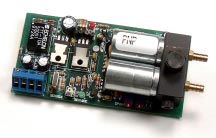
PNO-1 |
|
|
LonWorks Modulated High Pressure Pneumatic
Node
The LPN is a LonWorks compatible pneumatic output node. It uses the
LonTalk network protocol and an FTT-10A free topology bus transceiver.
The LPN uses standard kPa (kilopascals) SNVT
(Standard Network Variable Types) to measure and control the BRANCH line
output pressure from 137.9 to 689kPa (20 to 100PSI)in 6.9kPa (1PSI)
increments.
If the BRANCH set-point pressure cannot be
achieved within two minutes, or a leak is detected in the branch line, a
network alarm message is sent.
The LPN incorporates a SERVICE LED and SERVICE
push button switch for network configuration and troubleshooting.
The LPN incorporates two valves and bleeds no air
at setpoint.
It's branch exhaust flow and response time are
not limited by an internal restrictor and are similar to its load rate.
The LPN air manifold is tapped for 1/8" NPT
fittings (fittings to be supplied by customer).
If power fails to the LPN, branch line pressure
remains constant if the branch line does not leak air.
|

LPN |
|
|
Serial to LonWorks Node
The SLN allows the user to read and write to the configured serial
port, using either RS232 or RS485. (specify when ordering).
It is useful to interface other serial devices to
the LonWorks network.
SLN provides a custom bridge to an OEM product.
Requires custom pro-gramming of the Neuron chip
by AP or others.
The user (or installer) is required to provide an
interface to the on-board PIC-16c84 chip (8 data bits, 1 stop bit,
9600baud)
The SLN uses the LonTalk network protocol and an
FTT-10A free topology bus transceiver.
The SLN incorporates a SERVICE push button switch
and SERVICE LED for network configuration and troubleshooting.
|
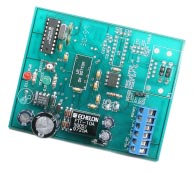
SLN |
|
|
LonWorksTM Network Repeater
The LRE added to a LonWorks TM network can effectively double
the system capability in the nodes or total wire distance are exceeded.
This repeater is designed for use with devices
using the FTT-10, FTT-10A and LPT-10 transceivers.
|
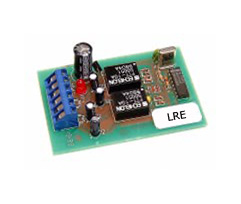
LRE |
|
|
LonWorks Network Terminator
The NTL provides a termination for a doubly terminated bus topology,
free topology, or TP/XF-78/TP/XF-1250 transceiver network.
|
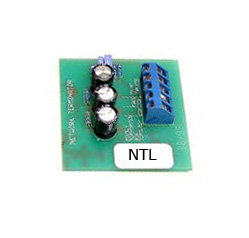
NTL |
|
|
|
|